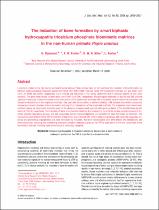 ResearchSpace
ResearchSpace
Induction of bone formation by smart biphasic hydroxyapatite tricalcium phosphate biomimetic matrices in the non-human primate Papio ursinus
JavaScript is disabled for your browser. Some features of this site may not work without it.
- ResearchSpace
- →
- Research Publications/Outputs
- →
- Journal Articles
- →
- View Item
| dc.contributor.author |
Ripamonti, U

|
|
| dc.contributor.author |
Richter, PW

|
|
| dc.contributor.author |
Nilen, RWN

|
|
| dc.date.accessioned | 2009-02-27T13:42:10Z | |
| dc.date.available | 2009-02-27T13:42:10Z | |
| dc.date.issued | 2008 | |
| dc.identifier.citation | Ripamonti, U, Richter, PW and Nilen, RWN. 2009. Induction of bone formation by smart biphasic hydroxyapatite tricalcium phosphate biomimetic matrices in the non-human primate Papio ursinus. Journal of Cellular and Molecular Medicine, vol 12(6B), pp 2609-2621. | en |
| dc.identifier.issn | 1582-4934 | |
| dc.identifier.uri | http://hdl.handle.net/10204/3097 | |
| dc.description | Copyright: 2008 Foundation for Cellular and Molecular Medicine/Blackwell Publishing Ltd. | en |
| dc.description.abstract | Long-term studies in the non-human primate Chacma baboon Papio ursinus were set to investigate the induction of bone formation by biphasic hydroxyapatite/β-tricalcium phosphate (HA/β-TCP) biomimetic matrices. HA/β-TCP biomimetic matrices in a pre-sinter ratio (wt%) of 40/60 and 20/80, respectively, were sintered and implanted in the rectus abdominis and in calvarial defects of four adult baboons. The post-sinter phase content ratios were 19/81 and 4/96, respectively. Morphological analyses on day 90 and 365 showed significant induction of bone formation within concavities of the biomimetic matrices with substantial bone formation by induction and resorption/dissolution of the implanted matrices. One year after implantation in calvarial defects, 4/96 biphasic biomimetic constructs showed prominent induction of bone formation with significant dissolution of the implanted scaffolds. The implanted smart biomimetic matrices induce de novo bone formation even in the absence of exogenously applied osteogenic proteins of the transforming growth factor-β(TGF-β) superfamily. The induction of bone formation biomimetizes the remodelling cycle of the cortico-cancellous bone of primates whereby resorption lacunae, pits and concavities cut by osteoclastogenesis are regulators of bone formation by induction. The concavities assembled in HA/β-TCP biomimetic bioceramics are endowed with multifunctional pleiotropic self-assembly capacities initiating and promoting angiogenesis and bone formation by induction. Resident mesenchymal cells differentiate into osteoblastic cell lines expressing, secreting and embedding osteogenic soluble molecular signals of the TGF-β superfamily within the concavities of the biomimetic matrices initiating bone formation as a secondary response | en |
| dc.publisher | Foundation for Cellular and Molecular Medicine/Blackwell Publishing Ltd. | en |
| dc.subject | Bone formation | en |
| dc.subject | Biphasic hydroxyapatite tricalcium phosphate | en |
| dc.subject | Osteogenic proteins | en |
| dc.title | Induction of bone formation by smart biphasic hydroxyapatite tricalcium phosphate biomimetic matrices in the non-human primate Papio ursinus | en |
| dc.type | Article | en |
| dc.identifier.apacitation | Ripamonti, U., Richter, P., & Nilen, R. (2008). Induction of bone formation by smart biphasic hydroxyapatite tricalcium phosphate biomimetic matrices in the non-human primate Papio ursinus. http://hdl.handle.net/10204/3097 | en_ZA |
| dc.identifier.chicagocitation | Ripamonti, U, PW Richter, and RWN Nilen "Induction of bone formation by smart biphasic hydroxyapatite tricalcium phosphate biomimetic matrices in the non-human primate Papio ursinus." (2008) http://hdl.handle.net/10204/3097 | en_ZA |
| dc.identifier.vancouvercitation | Ripamonti U, Richter P, Nilen R. Induction of bone formation by smart biphasic hydroxyapatite tricalcium phosphate biomimetic matrices in the non-human primate Papio ursinus. 2008; http://hdl.handle.net/10204/3097. | en_ZA |
| dc.identifier.ris | TY - Article AU - Ripamonti, U AU - Richter, PW AU - Nilen, RWN AB - Long-term studies in the non-human primate Chacma baboon Papio ursinus were set to investigate the induction of bone formation by biphasic hydroxyapatite/β-tricalcium phosphate (HA/β-TCP) biomimetic matrices. HA/β-TCP biomimetic matrices in a pre-sinter ratio (wt%) of 40/60 and 20/80, respectively, were sintered and implanted in the rectus abdominis and in calvarial defects of four adult baboons. The post-sinter phase content ratios were 19/81 and 4/96, respectively. Morphological analyses on day 90 and 365 showed significant induction of bone formation within concavities of the biomimetic matrices with substantial bone formation by induction and resorption/dissolution of the implanted matrices. One year after implantation in calvarial defects, 4/96 biphasic biomimetic constructs showed prominent induction of bone formation with significant dissolution of the implanted scaffolds. The implanted smart biomimetic matrices induce de novo bone formation even in the absence of exogenously applied osteogenic proteins of the transforming growth factor-β(TGF-β) superfamily. The induction of bone formation biomimetizes the remodelling cycle of the cortico-cancellous bone of primates whereby resorption lacunae, pits and concavities cut by osteoclastogenesis are regulators of bone formation by induction. The concavities assembled in HA/β-TCP biomimetic bioceramics are endowed with multifunctional pleiotropic self-assembly capacities initiating and promoting angiogenesis and bone formation by induction. Resident mesenchymal cells differentiate into osteoblastic cell lines expressing, secreting and embedding osteogenic soluble molecular signals of the TGF-β superfamily within the concavities of the biomimetic matrices initiating bone formation as a secondary response DA - 2008 DB - ResearchSpace DP - CSIR KW - Bone formation KW - Biphasic hydroxyapatite tricalcium phosphate KW - Osteogenic proteins LK - https://researchspace.csir.co.za PY - 2008 SM - 1582-4934 T1 - Induction of bone formation by smart biphasic hydroxyapatite tricalcium phosphate biomimetic matrices in the non-human primate Papio ursinus TI - Induction of bone formation by smart biphasic hydroxyapatite tricalcium phosphate biomimetic matrices in the non-human primate Papio ursinus UR - http://hdl.handle.net/10204/3097 ER - | en_ZA |





